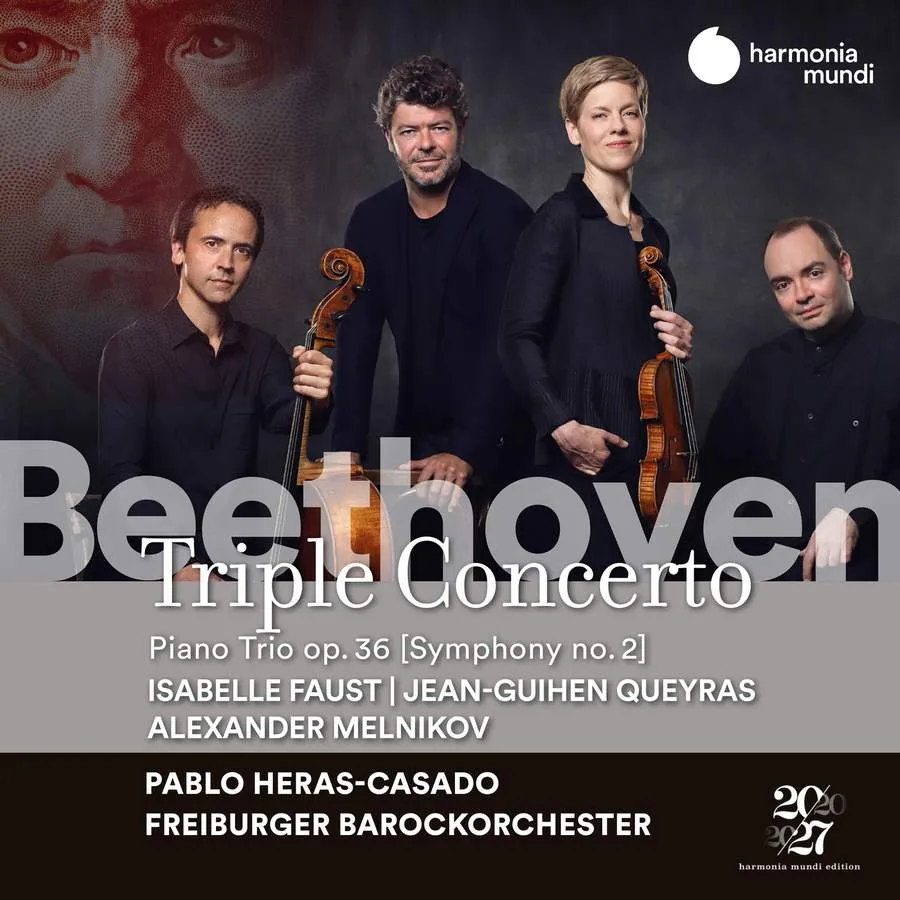
Beethoven Triple Concerto, Op. 56; Piano Trio, Op. 36 (after Symphony No. 2) Isabelle Faust (violin), Jean-Guihen Queyras (cello), Alexander Melnikov (piano); Freiburger Barockorchester/Pablo Heras-Casado Harmonia Mundi HMM902419 64:52 mins
Although it’s the Cinderella among Beethoven’s concertos, the Triple has had no shortage of recordings, with soloists occupying the gamut between three disparate big names at one end, to established trios at the other. Faust, Queyras and Melnikov, as well as having distinguished solo careers, have worked together often enough to be bedded in as a trio – their recordings of Schumann Trios and Concertos are a prime example of their talents in both of these areas.
The other significant contributors there were Heras-Cassado and the Freiburger Barockorchester, and they immediately grab the attention here as well, giving notice that this is going to be a powerful performance of the Triple Concerto. In the opening orchestral tutti, after the quiet start, the forward, vibrant sound and rhythmic unanimity give the impression of a far larger number of players than those named. There’s no question of a timid approach, and the clean timbre of the period instruments is echoed by the soloists, entering one by one. Especially fetching is the empathy between Faust and Queyras, with total mutual understanding of phrasing and rubato. The early 19th-century fortepiano adds piquancy to the texture, especially in the more turbulent minor-key sections, and Melnikov, equally attentive to detail and nuance, relishes the interplay with his performing partners.
The cello leads the soloists in each movement, and in the short Largo Queyras sings eloquently in a high register, enhanced by careful use of vibrato, before the piano enters with decorative figures. The pared-down orchestration gives the character of a piano trio movement with a few instrumental interpolations, and leads without a break to the Polonaise, dancing in outgoing fashion – although like the opening of the concerto, it starts quietly with the soloists’ sotto voce playing exquisitely judged. Rhythms are teasing and have an infectious swing in the minor-key episode; the whole concerto is a feast of enjoyment.
When we can hear our favourite pieces and explore new works at the click of a mouse or swipe of an app, it’s easy to forget that music-lovers in earlier times needed to be more hands-on, and this trio arrangement would have been an effective way for them to get to know the Second Symphony at home. In this performance, it comes across as more than a mere curiosity, helped by the imaginative variety of vibrato in the strings, and the sound of the fortepiano, a mellower instrument than the one used in the Concerto. Some may miss the orchestral colour of the original, especially in the wind department, but there’s no lack of bite: Melnikov’s finger-work is incisive and scintillating in the outer movements, attacks are tight, and the humour in the finale is nicely timed. The slow movement may seem a little brisk, but the Larghetto marking is qualified by quasi andante in this version (which may or may not be by Beethoven himself), and it lacks neither affection nor poise. Conversely, the scherzo is a little slower than might be expected, but never sits down, and forms an effective counterweight.
All in all this really is an outstanding recording.
Read more reviews of the latest Beethoven recordings
Find out more about Beethoven and his works
Martin Cotton
